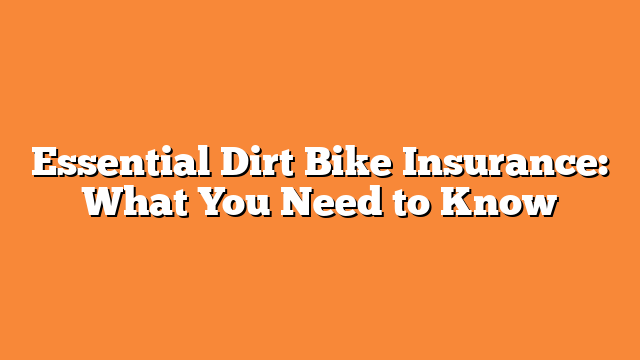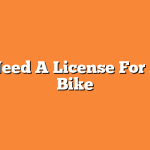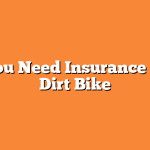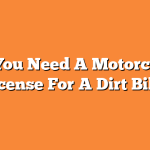Riding a dirt bike is an exciting way to explore the great outdoors, but it also comes with risks.
Do you need insurance for a dirt bike?
The short answer is yes.
Accidents happen, and you want to protect yourself and your ride.
In this post, we’ll discuss the ins and outs of dirt bike insurance, from coverage options to state requirements and more.
Keep reading to learn how to keep yourself financially and physically safe while riding your dirt bike.
Table of Contents
Why You Need Insurance for Your Dirt Bike
Riding a dirt bike can be an exhilarating experience, but it also comes with its set of risks.
Dirt bikes are considered off-road vehicles, and accidents can happen anytime, anywhere, and to anyone.
It is essential to have dirt bike insurance to protect yourself from financial burdens and legal complications if things go wrong.
Here are the reasons why you need insurance for your dirt bike:
- Protection from Liability: Dirt bike insurance covers liability insurance, which protects you in case you are found at fault for an accident.
It covers the cost of damages you caused, including medical expenses, property damage, and legal fees.
- Shield from Physical Damage: In case your dirt bike suffers damage due to an accident, insurance will cover the cost of repairs or replacement.
Physical damage coverage includes collision insurance, comprehensive insurance, and theft protection.
- Legal Protection: An accident involving a dirt bike can lead to legal repercussions if someone is injured or killed.
Insurance provides legal protection and covers the cost of legal fees if you are sued.
- Personal Injury Protection: Dirt biking can be risky, and accidents can result in severe injuries.
Personal Injury Protection (PIP) covers medical bills, lost wages, and other expenses related to treating the injuries.
- State Requirements: States have different requirements for insurance coverage, and may require you to have liability insurance.
Not having insurance and riding a dirt bike can lead to fines, penalties, and even suspension of your license.
- Financial Protection: Insurance provides financial protection and peace of mind.
In case of an accident, you don’t have to worry about the financial burden of damages or legal fees.
In summary, dirt bike insurance provides protection from financial and legal burdens, gives you peace of mind, and ensures that you comply with state requirements.
It covers liability, physical damage, and personal injury protection and shields you from legal issues that may arise from accidents involving your dirt bike.
If you’re planning to buy dirt bike insurance, it’s essential to understand the types of coverage available and legal requirements.
The next section will delve into this topic in detail.

What Types of Coverage Are Available
When it comes to dirt bike insurance, there are several types of coverage options available to help protect you and your vehicle.
Here are the most common types of dirt bike insurance coverage that you should consider:
- Liability Insurance: This type of insurance covers any damages or injuries you cause to other people or their property while riding your dirt bike.
Liability coverage is generally required by law in most states, so it’s essential to make sure you have enough protection to meet the minimum.
- Collision Insurance: If you’re involved in an accident with another vehicle or object, collision insurance will help cover the cost of repairing or replacing your dirt bike.
This coverage is not usually required by law but is highly recommended.
- Comprehensive Insurance: Comprehensive insurance covers damages to your dirt bike that are not caused by a collision, like theft, vandalism, or natural disasters.
It’s an important coverage option to consider if you use your dirt bike for recreational purposes or store it outside.
- Physical Damage Coverage: This type of insurance covers damages to your dirt bike, including collision and non-collision-related accidents.
Physical damage coverage includes both collision and comprehensive insurance, making it a more complete coverage option.
- Uninsured/Underinsured Motorist Coverage: If you’re involved in an accident with another vehicle that’s uninsured or underinsured, this coverage will help pay for damages to your dirt bike and medical expenses for any injuries you sustain.
When selecting coverage options, it’s essential to consider the level of protection you need and what your budget allows.
Keep in mind that the more coverage you have, the higher the premium will likely be.
In addition to the coverage options listed above, there may be additional insurance options to consider, like personal injury protection or medical payments coverage.
Be sure to discuss your options with your insurance provider to ensure you have the right amount of coverage for your needs.
Understanding the types of coverage available can help you make an informed decision about what insurance policy will work best for you and your dirt bike.
It’s important to keep in mind that each state has its own set of insurance requirements, so familiarizing yourself with these laws is crucial when shopping for dirt bike insurance.
Understanding Legal Requirements
When it comes to operating a dirt bike, many riders may wonder about the legal requirements for insurance.
It’s important to understand the legal requirements in your state, as it can vary from state to state.
Here are some key points to keep in mind when it comes to the legal requirements for dirt bike insurance:
- Liability Insurance: In most states, liability insurance is required for dirt bikes and other off-road vehicles.
This type of insurance covers injuries or damages that you may cause to someone else or their property while riding your dirt bike.
- Uninsured/Underinsured Motorist Coverage: Some states also require dirt bike riders to have uninsured/underinsured motorist coverage.
This type of insurance covers you if you’re hit by a driver who doesn’t have insurance or doesn’t have enough insurance to cover your damages.
- Personal Injury Protection/Medical Payments Coverage: Depending on your state, you may be required to carry personal injury protection or medical payments coverage.
These types of insurance provide coverage for medical expenses for you and your passengers if you’re injured while riding your dirt bike.
It’s important to keep in mind that the legal requirements for dirt bike insurance can change, so it’s always a good idea to check with your state’s DMV or insurance commissioner to make sure you’re up to date on the latest laws and regulations.
In addition to understanding the legal requirements, it’s also a good idea to consider additional coverage options for your dirt bike.
Here are some types of coverage that you may want to consider:
- Collision Insurance: This type of insurance covers damage to your dirt bike in case of an accident.
- Comprehensive Insurance: Comprehensive insurance covers damage to your dirt bike from non-collision events, such as theft, vandalism, or weather-related damage.
- Physical Damage Coverage: Physical damage coverage can provide additional protection for your dirt bike in case of an accident or other event that causes damage.
- Theft Protection: This type of coverage can provide you with financial protection in case your dirt bike is stolen.
When it comes to shopping for dirt bike insurance, it’s important to compare quotes from multiple insurance providers.
Factors that can affect your insurance cost include your driving record, the type of dirt bike you have, and the level of coverage you choose.
Finally, it’s important to remember that safety should always be a top priority when riding your dirt bike.
Wearing protective gear and following safe riding practices can help reduce the risk of accidents and injuries.
In summary, understanding the legal requirements for dirt bike insurance is important for all riders.
While liability insurance is typically required, additional coverage options can also provide valuable protection.
Shopping around for the best insurance rates and prioritizing safety can help you enjoy your dirt bike while staying financially protected.
Factors That Affect Insurance Cost
When it comes to insurance for your dirt bike, several factors can affect the cost.
Knowing what these factors are can help you make an informed decision about the coverage you need and how much you’ll pay for it.
Here are some of the key factors that can affect the cost of your dirt bike insurance:
- Your driving record: Your driving record is one of the most significant factors that insurers consider when determining your insurance rates.
If you have a history of accidents or violations, you are considered more of a risk, and your rates will be higher.
- Type of coverage: The type of coverage you choose will also affect the cost of your insurance.
Liability insurance is the least expensive option, while collision and comprehensive insurance will be more expensive.
- Amount of coverage: The more coverage you have, the more you will pay for insurance.
However, having more coverage can provide greater peace of mind and financial protection in the event of an accident.
- Type of bike: The type of dirt bike you own can also affect the cost of your insurance.
A more expensive bike will be more expensive to insure because it will cost more to repair or replace if it is damaged or stolen.
- Age and experience: Younger riders and less experienced riders are considered higher risk by insurers, and therefore their rates will be higher.
- Location: The location where you live and ride your dirt bike can also affect your insurance rates.
If you live and ride in an area with high accident rates, your rates will be higher.
- Discounts: Insurance companies offer a variety of discounts that can help lower your insurance costs.
Some common discounts include safe driving discounts, multi-policy discounts, and bundling discounts.
It’s essential to keep in mind that insurance rates can vary significantly between insurers, and it’s essential to shop around for the best rates.
You should also consider the level of coverage you need and what you can afford to pay before making a final decision on your dirt bike insurance policy.
In conclusion, several factors can affect the cost of your dirt bike insurance, including your driving record, type of coverage, amount of coverage, type of bike, age and experience, location, and discounts.
By understanding these factors and shopping around for the best rates, you can ensure that you have the coverage you need without breaking the bank.

How to Shop for Dirt Bike Insurance
When it comes to shopping for dirt bike insurance, there are a few things to keep in mind to ensure you get the best coverage at the most affordable rates.
Here are some tips to help you navigate the process:
- Determine your insurance needs: Before you start shopping for dirt bike insurance, it’s crucial to assess your coverage needs.
Consider the type of riding you do, how often you ride, and where you ride.
This information will help you determine what types of coverage you need.
- Check state requirements: Each state has its own insurance requirements for dirt bikes and other off-road vehicles.
Research your state’s insurance laws and make sure you meet the minimum coverage requirements.
- Compare insurance quotes: Get quotes from multiple insurance providers to compare rates and coverage options.
When collecting quotes, be sure to ask about any discounts or special offers the provider may offer.
- Consider your deductible: The deductible is the amount you’ll pay out of pocket before the insurance coverage kicks in.
Typically, the higher your deductible, the lower your monthly premiums.
However, you should choose a deductible that you can comfortably afford in the event of an accident.
- Understand your coverage options: Dirt bike insurance typically consists of liability insurance, collision insurance, and comprehensive insurance.
However, you may also want to consider extra coverage options like physical damage coverage, theft protection, and uninsured/underinsured motorist coverage.
- Check for exclusions: Be sure to read the fine print and check for any exclusions in the insurance policy.
Some policies may not cover racing or certain types of off-road riding.
- Choose a reputable provider: Choose an insurance provider with a good reputation and a proven track record of paying out claims.
Check online reviews and ask for referrals from fellow riders.
By following these tips, you can find the right dirt bike insurance coverage to protect yourself, your bike, and your finances.
Remember to prioritize safety when riding, always wear protective gear, and stay up to date on your insurance policy.
Staying Safe on Your Dirt Bike
Even with comprehensive dirt bike insurance coverage, accidents can happen.
Therefore, it’s essential to take safety precautions to protect yourself from injuries and prevent accidents.
Always wear protective gear when riding your dirt bike.
This includes a properly fitting helmet, gloves, goggles, boots, and durable clothing that covers your arms and legs.
Protective gear can help mitigate injuries in the event of an accident and protect you from dust, debris, and other elements on the trail.
When riding your dirt bike, it’s crucial to follow all traffic laws and regulations in your area.
Always ride within your comfort level and consider the terrain before you start your ride.
Off-road riding requires different techniques than on-road riding, so make sure you understand the differences and practice safe riding.
Be aware of obstacles such as rocks, logs, and big jumps on the trail, and adjust your speed accordingly.
It’s also crucial to know your limits and be honest with yourself about what you and your dirt bike can do.
Steer clear of areas with high risks of accidents, such as fast-moving traffic, steep hills, and soft sand.
When possible, choose to ride with an experienced friend who can guide you through new terrain, teach you new techniques, and help you ride with confidence.
Maintaining your dirt bike is equally important for safety.
Always check your dirt bike before and after each ride to ensure everything is functioning correctly.
Maintain proper tire pressure, keep your chain lubricated, and check your brake pads and fluid routinely.
Regular maintenance will minimize the risk of unexpected issues and ensure that your dirt bike is safe to ride.
Remember that safety on your dirt bike is crucial not only for yourself but for others sharing the trail with you.
By following safety guidelines, you’ll reduce your risk of accidents and enjoy your dirt bike safely and responsibly.
Wrapping Up
After assessing the risks and options, it is clear that dirt bike insurance is a must-have for any rider.
While it is not legally required in every state, it is the smart and responsible choice to protect yourself, your motorcycle, and others on and off the road.
When shopping for dirt bike insurance, it is important to understand the types of coverage available, as well as the state laws and insurance requirements.
Liability insurance is the most basic and mandatory type of coverage, while collision and comprehensive insurance provide further protection against physical damages, theft, and other incidents.
It is also recommended to consider uninsured/underinsured motorist coverage and medical payments coverage for added financial protection in case of an accident or injury.
Factors that affect the cost of dirt bike insurance include the type and model of the motorcycle, the rider’s age and driving history, and the coverage chosen.
To find the best insurance policy with the ideal coverage and rates, it is crucial to do research and compare quotes from different providers.
Aside from insurance, it is equally important to prioritize motorcycle safety and use proper protective gear.
Dirt bike accidents can still happen despite precautions, so having legal protection and personal injury protection can offer additional peace of mind.
In summary, dirt bike insurance is a key factor in being a responsible and prepared rider.
With the right coverage in place and safe riding practices, riders can fully enjoy the thrills of their dirt bike while minimizing the risks and potential financial consequences.







